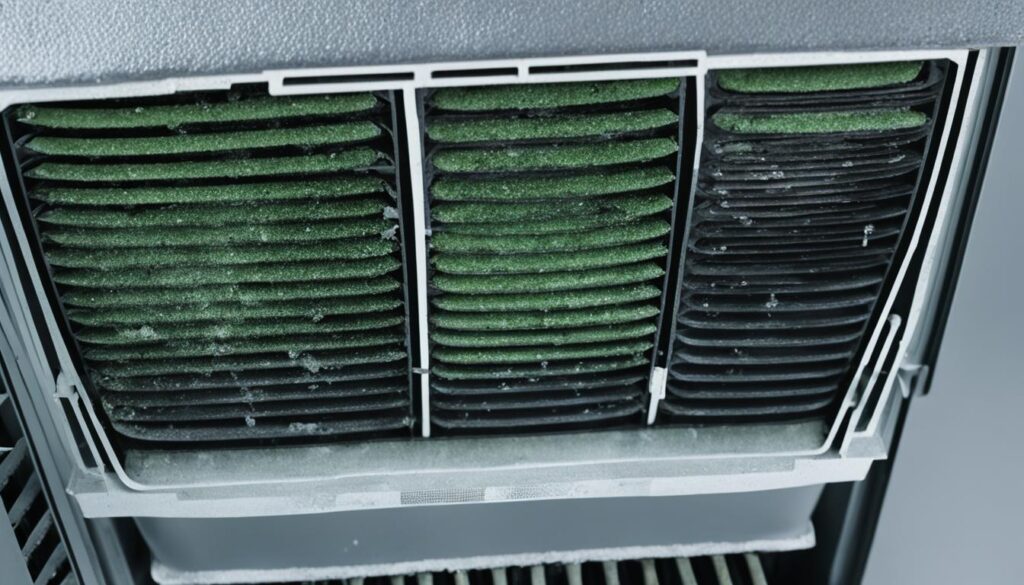
Jello Egg Mold – Create Festive Easter Treats
Are you looking for a fun and creative way to celebrate Easter? Look no further than the Jello Egg Mold! This innovative kitchen gadget allows you to make adorable and delicious jello eggs that will surely impress your family and friends.
But before we dive into the exciting world of jello egg molds, it’s important to address a common issue that many homeowners face: mold growth in air conditioner units. Mold in air conditioners can lead to a variety of problems, including compromised indoor air quality and potential health risks. In this section, we will explore the causes of mold growth in air conditioner units, the risks it poses, and the methods for prevention.
Key Takeaways:
- Mold growth in air conditioner units can cause indoor air pollution and health issues.
- The main causes of mold in air conditioners are moisture, poor ventilation, and dirty filters.
- Risks associated with mold growth in air conditioners include respiratory problems, allergies, and asthma attacks.
- Preventing mold in air conditioners involves regular cleaning, proper maintenance, and controlling humidity levels.
- If you suspect mold in your air conditioner, it’s essential to address the issue promptly to avoid further complications.
Signs of Mold Growth in Air Conditioner Units
When it comes to your air conditioner, signs of mold growth should never be ignored. Not only can mold compromise the performance and lifespan of your unit, but it can also negatively impact your indoor air quality and pose health risks to you and your family. Being able to detect mold growth in your air conditioner is crucial for taking immediate action and preventing further damage.
Here are some common signs that indicate the presence of mold in your air conditioner:
- Musty Odors: If you notice a strong, unpleasant smell coming from your air conditioner, it could be a sign of mold growth. Mold has a distinct musty odor that can permeate your home when the unit is running.
- Visible Mold Growth: Look closely at your air conditioner for any visible signs of mold. It may appear as dark spots or patches on the unit’s surfaces, such as the cooling coils, vents, or ducts.
- Increased Allergy Symptoms: If you or your family members experience worsened allergy symptoms, such as sneezing, coughing, or watery eyes, when the air conditioner is in use, it could be a result of mold spores circulating in the air.
- Water Leaks: Mold requires moisture to grow, so any signs of water leaks or excessive condensation around your air conditioner could indicate a mold problem. Check for water stains, damp spots, or pooling water near the unit.
- Reduced Airflow: Mold growth within your air conditioner can obstruct airflow, causing reduced cooling efficiency and poor distribution of conditioned air throughout your home.
By being aware of these signs, you can quickly identify and address mold growth in your air conditioner. Prompt action is essential to prevent further mold proliferation and to safeguard your health and well-being.
“Promptly addressing mold growth in your air conditioner is crucial for maintaining a healthy indoor environment and preventing potential health issues.”
So, what should you do if you suspect mold in your air conditioner? In the next section, we will share the steps and best practices to effectively remove mold from your unit and ensure a clean and mold-free cooling system.

| Signs of Mold Growth in Air Conditioner Units | Description |
|---|---|
| Musty Odors | A strong, unpleasant smell emanating from the air conditioner when in operation. |
| Visible Mold Growth | Dark spots or patches of mold on the surfaces of the air conditioner, such as cooling coils, vents, or ducts. |
| Increased Allergy Symptoms | Worsened allergy symptoms, such as sneezing, coughing, or watery eyes, while the air conditioner is running. |
| Water Leaks | Signs of water leaks or excessive condensation around the air conditioner. |
| Reduced Airflow | Decreased airflow and poor distribution of conditioned air throughout the home. |
Removing Mold from Air Conditioners: Steps and Best Practices
Mold growth in air conditioner units can affect the air quality in your home and pose health risks to occupants. Proper mold removal is crucial to maintain a clean and healthy environment. In this section, we will guide you through the necessary steps and best practices for effectively removing mold from your air conditioner.
Step 1: Turn off the air conditioner
Before beginning the mold removal process, ensure that the air conditioner is turned off and disconnected from the power source. This will prevent any accidents or electrocution while handling the unit.
Step 2: Disassemble the unit
Next, carefully disassemble the air conditioner unit to access all the components where mold may be present. Remove the front cover, filters, and any other removable parts according to the manufacturer’s instructions.
Step 3: Wear protective gear
It is crucial to protect yourself from mold spores and cleaning chemicals during the mold removal process. Wear gloves, safety goggles, and a respiratory mask to ensure your safety.
Step 4: Clean the components
Thoroughly clean all the components of the air conditioner that may have mold growth. Use a mixture of mild detergent and warm water to scrub away the mold. Ensure that the cleaning solution is non-toxic and approved for use on air conditioning systems.
Step 5: Rinse and dry
After cleaning the components, rinse them thoroughly with clean water to eliminate any residues. Allow the parts to air dry completely before reassembling the air conditioner.
Step 6: Clean the air ducts
In addition to cleaning the components, it is essential to address any mold growth in the air ducts. Use a specialized air duct cleaner or hire a professional to ensure a thorough cleaning of the ductwork.
Best Practices for Mold Removal:
- Regularly inspect and clean your air conditioner to prevent mold growth.
- Ensure proper ventilation in the area where the air conditioner is installed.
- Maintain the recommended humidity levels in your home to discourage mold growth.
- Consider using a dehumidifier in areas prone to excessive moisture.
- Immediately address any signs of mold growth, such as musty odors or visible mold.
- If the mold growth is extensive or persistent, consult a professional mold remediation specialist.
Remember, mold removal from air conditioners requires caution and thoroughness. Follow the steps and best practices outlined above to ensure effective mold removal and maintain a healthy indoor environment.

| Mold Removal Steps | Best Practices |
|---|---|
| Turn off the air conditioner | Regularly inspect and clean your air conditioner to prevent mold growth. |
| Disassemble the unit | Ensure proper ventilation in the area where the air conditioner is installed. |
| Wear protective gear | Maintain the recommended humidity levels in your home to discourage mold growth. |
| Clean the components | Consider using a dehumidifier in areas prone to excessive moisture. |
| Rinse and dry | Immediately address any signs of mold growth, such as musty odors or visible mold. |
| Clean the air ducts | If the mold growth is extensive or persistent, consult a professional mold remediation specialist. |
Conclusion
In conclusion, understanding the causes, risks, and prevention of mold growth in air conditioner units is essential for maintaining a fresh and healthy home environment. Mold growth in air conditioners can lead to various health issues, such as allergies, asthma, and respiratory infections.
By promptly addressing any signs of mold growth, such as musty odors or visible mold, you can prevent further damage to your air conditioner and protect the well-being of your household. Regular maintenance, including cleaning and disinfecting the unit, is crucial in preventing mold growth.
If you suspect mold in your air conditioner or require professional assistance, it is recommended to reach out to a trusted mold assessment and remediation service. Fix Mold Miami, at 305-465-6653, offers professional mold assessments and remediation services to ensure the optimal functioning of your air conditioner and the safety of your home.




